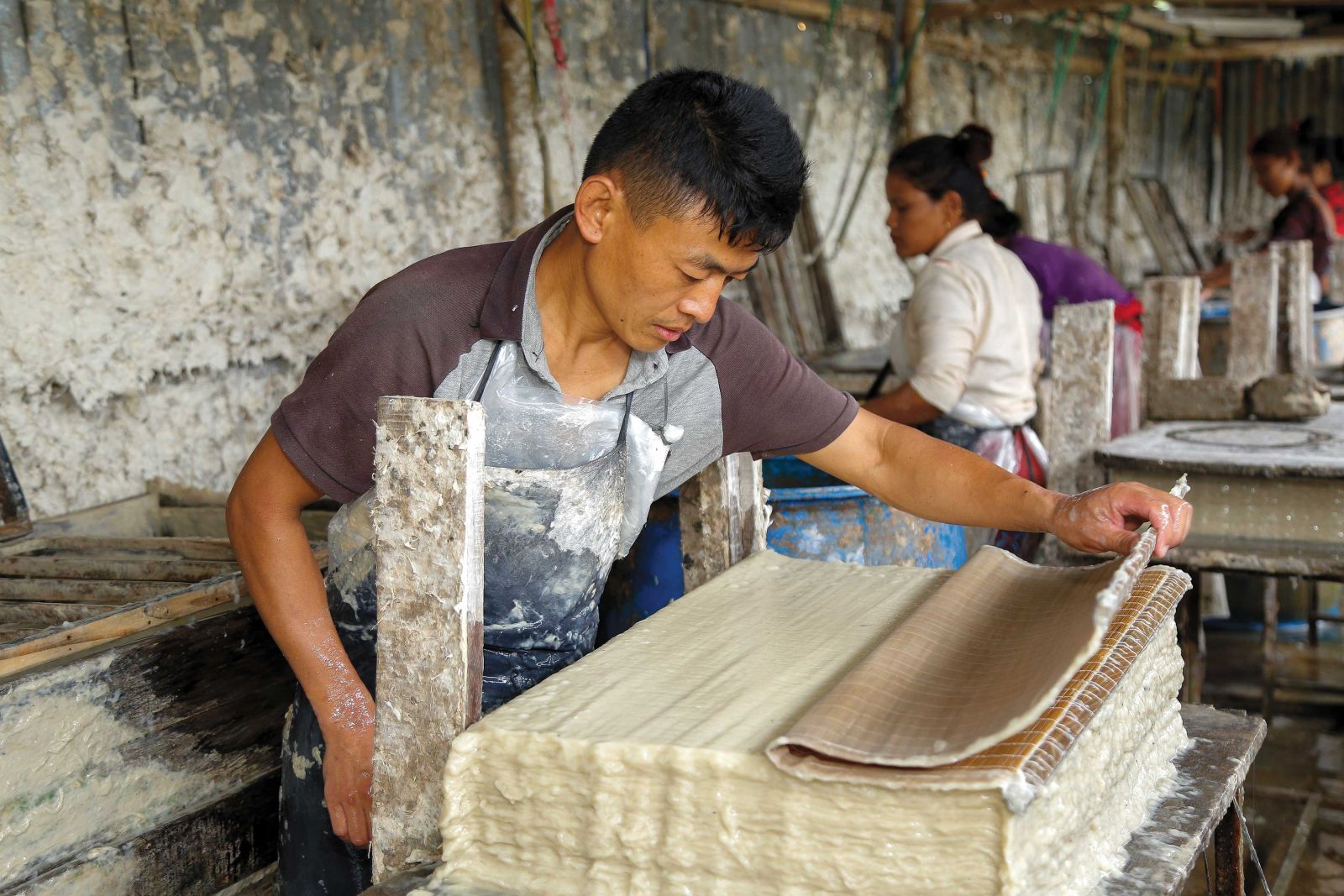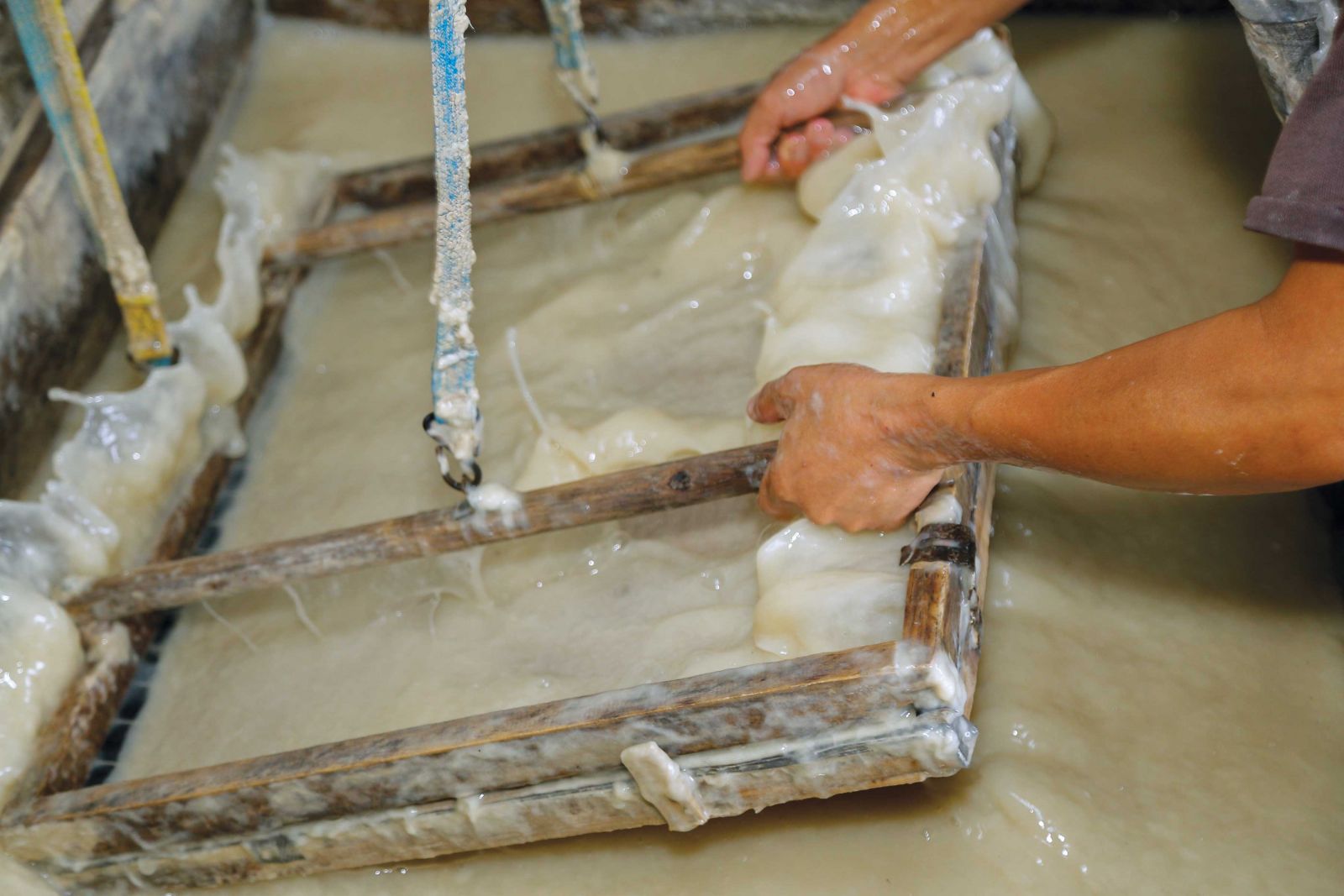
Paper lanterns diffuse yellow lighting and spread the glow in all directions, making the hall warm. Covers of journals are dyed and decorated differently, beneath which are well-cut inner pages that smell of the sun and feel of nature. This is just one of the gift shops selling handicrafts made of lokta paper, a product unique to Nepal.
But it’s not just found in shops for tourists—it’s used in many ways throughout local daily life: restaurant menus, prayer flags, notebooks, government paperwork, name cards.

Lokta paper, known as Nepali handmade paper, has more than 1000 years of history. The oldest existing lokta paper is the Karanya Buha Sutra, a Buddhist text, that is between 1000 and 1900 years old. It is now preserved in Nepal’s National Archives in Kathmandu.
A unique and important feature of lokta paper is that it is one of the very few products with all the elements of the production chain coming from local resources, including raw materials, labor, and manufacture.

Lokta paper is made from the lokta bush which grows on the southern slopes of the Himalaya, at an altitude of 1600 to 4000 meters. It’s harvested in September and October and will be stocked for one year’s production. Workers peel the bark off and boil it for around five hours. Then the bark is smashed into pulp which will be mixed with water and poured into flat wooden frames to dry in the sun.
You can see the sunlight running over the strong lokta fiber pulp like an iron gliding back and forth, removing wrinkles, and a natural paper is born. It’s resistant to water, germs and insects, with rich texture and durability.
This scene is happening every day at Narendra Saud’s factory. Narendra has been in the handmade paper industry for almost thirty years, taking over the business from his father. Apart from running the factory in Accham, Narendra and his partner Surendra opened one in Kathmandu, with ten to twelve employees, all but two women.

For now, human labor is mainly used to produce lokta paper, resulting in relatively small production compared to standard paper which is produced in automatic lines. And that’s what makes lokta paper so special. The only machine that appears in its production is the one that smashes the fiber into small pieces. “That’s why it is called handmade paper or man-made paper, not machine-made,” Narendra said.
Dried in the sun, dyed all by hand, each sheet is one of a kind.
Handwork was once synonymous with low productivity with the rise and popularity of industrialization. Mass production brings yield and efficiency up, but at the same time, the very monotony of a product makes us lose a lot.
In the production assembly line, papers are made into the same shape with sharp edges while the mark of nature remains on the sun-kissed side, the more naturally formed side of lokta paper.

When asked about the reason why tourists are so into handmade paper, many of them come to a similar answer, “It is weighted,” but not heavy. Turning to handmade work that carries time and effort, we can feel the unique workmanship, history, creativity, and artistry.
Customers come from varied fields and different countries—some are government officials who use lokta paper for official documents and others are businesspeople who make handicrafts out of it.
Here comes another facet, the joy of creative collusion in different fields. What can lokta paper be made into? Like many other kinds of paper, it can be written on—so it becomes a menu, a journal or even a name card. After it dresses up, dyed into a different color, a bit of accessory added, flowers or leaves, then it gains more artistic value from the beauty and has a gift carried in it.
What if it doesn’t present as paper anymore? Three more spoons of imagination, and cook it with creativity, then it turns into a “freshly baked” jewelry, a bracelet, a necklace, a ring, or a pair of earrings.
It becomes an art.
Lokta jewelry designed by Vasiliki Merianou, the founder of a Swiss brand of lokta art, even took part in exhibitions, including the Artistar Jewels 2019 Exhibition at the Palazzo Bovara in Milan. Coming from Nepal, it goes global.
And it comes back, as with Aveda, an American brand that puts effort into creating income for people. The number women who constitute 90% of its papermakers and are empowered to support their families, has reached 4490. With the income, their children can enjoy education rather than farming to help to support the family. Today 5,885 children are dreaming big in school.
And Aveda is not the only one who cares. Rural poverty in remote areas in Nepal is being alleviated because of handmade paper production.
About 4000 families in rural areas and another 2500 people in Kathmandu are employed in the industry, 80% of which are poor women from disadvantaged ethnic groups, according to GIZ.
Following a tradition from over 1000 years ago, lokta paper is not getting old or out of date but thriving with new elements that matter a lot—the craft is a tradition, emotional sustenance and the continuation of life.
Every sheet of lokta paper tells a different story. Find out yours.
Some lesser-known vegetable dishes from the southern plains
I’m not a vegetarian but I love vegetables. And whenever I get to the southern plains of Nepal, I try...










